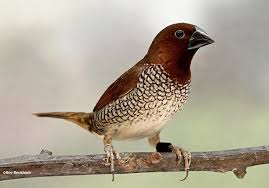Spice Finch

Description
The spice finch or spotted munia (Lonchura punctulata), known in the pet trade as nutmeg mannikin or scaly-breasted munia, is a sparrow-sized estrildid finch native to tropical Asia. A species of the genus Lonchura, it was formally described and named by Carl Linnaeus in 1758. Its name is based on the distinct scale-like feather markings on the breast and belly. The adult is brown above and has a dark conical bill. The species has 11 subspecies across their range and differ slightly in size and colour.
This munia eats mainly grass seeds apart from berries and small insects. They forage in flocks and communicate with soft calls and whistles. The species is highly social and may sometimes roost with other species of munias. This species is found in tropical plains and grasslands. Breeding pairs construct dome-shaped nests using grass or bamboo leaves.
The species is endemic to Asia and occurs from India and Sri Lanka east to Indonesia and the Philippines (where it is called mayang pakíng). It has been introduced into many other parts of the world and feral populations have established in Puerto Rico and Hispaniola as well as parts of Australia and the United States of America. The bird is listed as of Least Concern by the International Union for Conservation of Nature (IUCN).
The scaly-breasted munia is about 11–12 centimetres (4.3–4.7 in) long and weighs 12–16 grams (0.026–0.035 lb). The adult has a stubby dark bill typical of grain eating birds, brown upperparts and a dark brown head. The underparts are white with dark scale markings. The sexes are similar, although males have darker markings on the underside and a darker throat than females.
Immature birds have pale brown upperparts, lack the dark head found in adults, and have uniform buff underparts that can be confused with juveniles of other munia species such as the tricolored munia (Lonchura malacca) across the Asian and island populations and the black-throated munia (Lonchura kelaarti) in parts of India or Sri Lanka. Populations within their wide distribution range show variations in plumage color and size.
Along with other Estrildines, these species are thought to have originated in Asia. The species has been introduced to other parts of the world due to its popularity as a cage bird and populations have established in the wild.
Scientific Name
Lonchura Punctualta
Country Of Origin
Size
Life Expectancy
Noise Level
Quiet
Characteristics
Spice finches are distinctive looking, with beautiful scaling on their chest and underbelly. Spice finches are even tempered and not too demanding, making them a popular pet bird choice. Spice finches are pleasant, social birds that live in small groups in the wild. A group of pet spice finches can be housed with other bird species, provided the other species are not aggressive toward them. They are active and need sufficient space to fly and perch. Although spice finches enjoy the company of their pet bird owners, they are best kept in society finch flocks. Males will sing quietly during courtship, while female spice finches tend to be quieter.
Behavior / Health Concerns
Spice finches should have a well-ventilated, well-lit living space, but they should be kept away from constant drafts, which can cause illness. They should eat a good finch seed mix, along greens, egg food, mealworms, as well as fruits and vegetables. They love swings and enjoy hanging from different things. They also enjoy bathing and should be given the opportunity to do so in a shallow dish of clean water. Spice finches look like they are zooming rather than flying, and because of their high-energy level, they should be housed in a large flight cage or aviary.
Expert Advice
“Spice finches are are nice, quiet birds ideally kept in colonie. Young birds are dusky color and achieve their adult plumage at around 7 months of age.”
Susan Newman, Wind Song Aviary